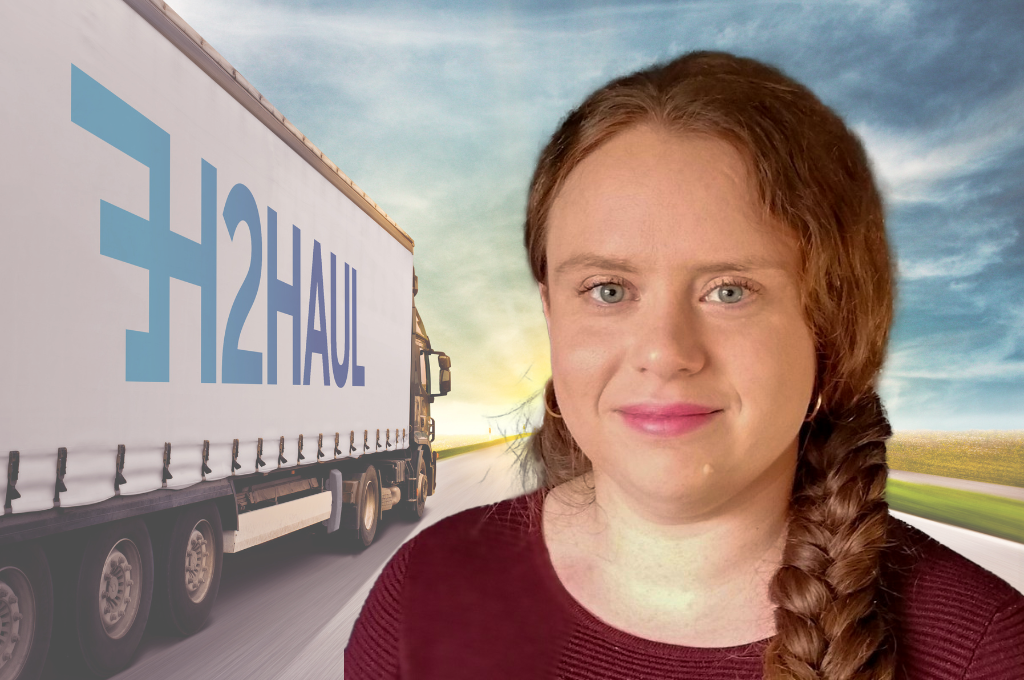We interviewed Stefanie Van Damme, a research and development engineer at Colruyt Group. She has been involved in hydrogen projects since 2018. Her knowledge and experience in hydrogen refuelling stations (HRS) have significantly contributed to developing one of the four HRS of the H2Haul project.
Please tell us a little bit about yourself. What is your speciality, and what are you passionate about?
Hi, I’m Stefanie Van Damme, I work as R&D engineer for Colruyt Group. In 2018, I started working on hydrogen projects, and H2Haul was the first project for which I did project management. Before 2018, I taught thermodynamics and learned to appreciate this domain of science. The design of a hydrogen refuelling station is all thermodynamics, so within H2Haul, I can put my theoretical knowledge into practice and develop refuelling concepts for greener transport.
Let’s talk about the technology you are working on now. Why do you think hydrogen is a good solution for heavy applications?
The main advantages of hydrogen are its fast-refuelling time compared to battery electric solutions and its transportable energy carrier. Battery electric and fuel cell electric applications will coexist in the future. The well-to-wheel energy efficiency of battery electric trucks is higher; we should use them in the logistic processes where they can be applied.
However, hydrogen trucks, with their fast refuelling, and in the case of 700 bar trucks, their range of more than 700km, can bring well-needed flexibility to a fleet. Also, due to grid restrictions, fast charging a fleet of battery electric trucks will only be possible in some places. Supplying energy by a molecule can be a solution, as it is done today.
What are the main challenges regarding hydrogen refuelling stations today?
I see three main challenges:
Firstly, technology is evolving towards 700 bar refuelling to achieve drive ranges comparable to diesel. At H2Haul, a partner from France will demonstrate the first 700-bar truck and refuelling station. However, the necessary refuelling hardware and protocols are still being developed, especially to achieve high flow refuelling of a truck at 700 bar.
Secondly, to refuel gaseous hydrogen, it has to be compressed to 1000 bar and cooled. These processes require energy and therefore impact the price of hydrogen for end-users. Therefore, further research is needed to optimise the operation and concept of a hydrogen refuelling station. The aim is to reduce the energy requirement and the overall cost to condition the hydrogen. This can be achieved in different ways: by adjusting the refuelling protocol, improving compression, or using a new hydrogen storage concept.
And thirdly, green hydrogen must be available at a realistic price for the transport sector. If hydrogen is not green, emissions are not reduced compared to diesel.
Colruyt Group, with DATS 24 and Virya Energy, Colruyt Group’s energy holding, are working to establish the whole hydrogen value chain and green hydrogen for mobility. Colruyt Group invests in renewable energy assets and plans to expand the H2Haul station with 700 bar technology and local, green hydrogen production. Virya Energy focuses on the large-scale production of green hydrogen. And DATS 24 ensures distribution via its refuelling sSo thatons. That is a perfect combo to shape that value chain.
How has the H2Haul project helped?
H2Haul is the first project where fleets of hydrogen trucks will be demonstrated, not just one. Previous hydrogen truck projects, like Hydrogen Region 2.0 and H2Share, two projects on which Colruyt Group and VDL already worked together, developed and demonstrated one hydrogen truck. In H2Haul, Colruyt Group and VDL will demonstrate a fleet of 4 trucks over two years, which will give more insight into the hydrogen station and truck operation and how the fuel cell truck technology is improving compared to the previous truck generation. This is yet another critical step forward.
What are the advantages and value propositions for operators to adopt this new technology?
The main advantage is sustainability. Driving with electric trucks, whether battery electric or fuel cell electric, is less impact than diesel trucks when the energy source they use is renewable.
Nevertheless, hydrogen technology for trucks demands high investments and know-how. Further development of the hydrogen industry and becoming an industry of scale will be necessary to lower costs. Legislative incentives, like carbon taxes and emission bans in city centres, will also be crucial to create an environment for hydrogen trucks.
Colruyt Group wants to be a frontrunner in hydrogen for mobility and invests in refuelling equipment. We want to join forces with innovative companies like the H2Haul partners and build solutions for zero-emission transport. We want to show other retailers and transport firms how zero emissions can be achieved and lead the way to a viable business case.
Can you tell us more about Colruyt Group’s hydrogen applications? What is the next milestone, and what progress has been made so far?
The first studies on hydrogen were already done in 2012. The first commercial installation was a hydrogen refuelling station for passenger cars in Halle, which opened in 2018. This was Europe’s first fully integrated hydrogen station, which dispenses locally produced green hydrogen. The station is mainly used by the fleet of 20 hydrogen cars of Colruyt Group. Two other passenger car stations followed this year, with two more coming. In addition, the H2Haul station, specially designed for 350 bar trucks, will be inaugurated. In 2024, we hope to expand the H2Haul station with local, green hydrogen production and upgrade to 700 bar.
Is there anything else you would like to add?
I want to thank the extraordinary team that makes these hydrogen projects possible. Within Colruyt Group, a dedicated team of project engineers, buyers, legal advisors, and technicians work together to make the hydrogen projects successful; without them building a hydrogen station would be impossible. And, of course, also the teams of our H2Haul partners, VDL and Plastic Omnium. Because without the trucks, the station would have no purpose. Together we can solve the chicken and the egg problem.
